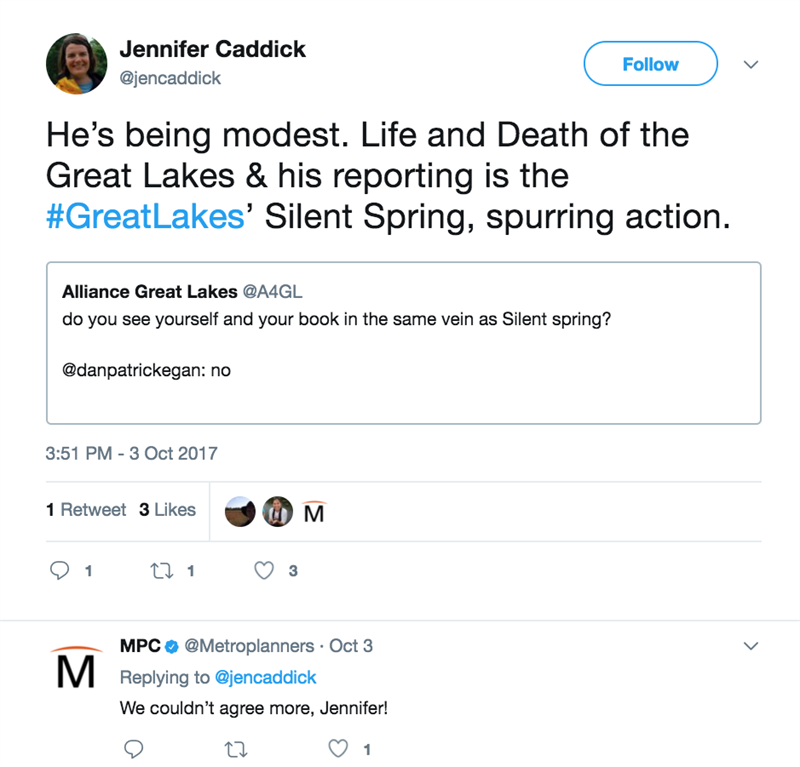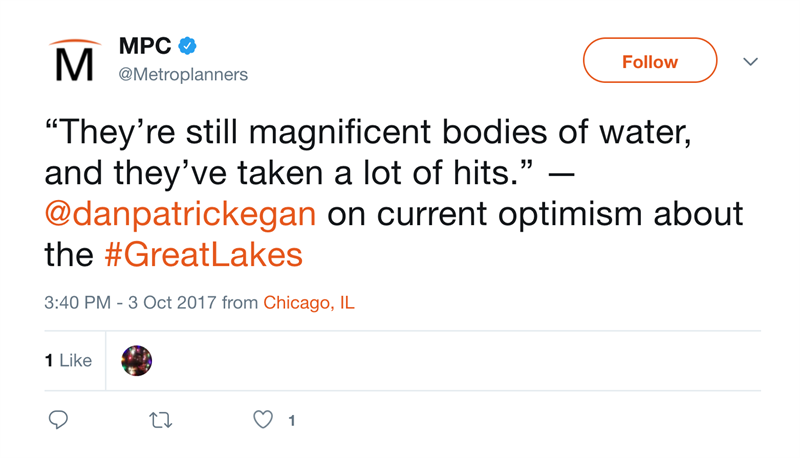At an event that sold out in merely three days, the Metropolitan Planning Council and the Alliance for the Great Lakes hosted two-time Pulitzer Prize finalist Dan Egan to discuss his new book The Death and Life of the Great Lakes, winner of the J. Anthony Lukas Award.
Egan was interviewed by WBEZ’s Monica Eng, who asked pointed questions about invasive species, climate change and the St. Lawrence Seaway—as well as about eating whitefish and trout!
Joel Brammeier, President and CEO of the Alliance for the Great Lakes, opened the event by placing the conversation into context: the Great Lakes represent an incredible source of surface freshwater right in our backyards, a full 20 percent of the world’s supply.
LIQUID DESERT
Dan Egan almost called his book by another name.

He had good reason for this.
In his book, Egan chronicles the fascinating history of constructing the St. Lawrence Seaway, including the pivotal Welland and Erie Canals in the late 19th century, after which the lakes forged an immediate link to the Atlantic Ocean. Egan outlines the series of events which triggered an ecological calamity now that the “front door” protecting the lakes for millennia had been jarred open. In particular, he recounts the rise and fall of three species of fish—lake trout, sea lampreys and alewives.
These waves of ecological trouble decimated the upper Great Lakes’ population of native predators. Due to such a decline of the Great Lakes, Egan recounts how people, towns and entire recreational fishing industries turned their backs on them. Struggling fisherman and grown adults recalling the Great Lakes of their childhood share the same sentiment that “this isn’t the lake it was 25 years ago, and it’s probably not the same lake it’s going to be in 10 years.”
UNWELCOME CARGO ON OVERSEAS SHIPS
With the opening of the St. Lawrence Seaway in 1959 attracting oceangoing freighters into the Great Lakes came unforeseen consequences of biological pollution, most notably zebra and quagga mussels among other invaders which in no time decimated native species and significantly disrupted the age-old ecosystem.
Egan explains in his book that Great Lakes shipping is vitally important to the region, but overseas shipping is not that significant economically, despite harboring the lion’s share of the environmental threat to the lakes:
- One study has shown that a single freighter ballast tank can harbor some 300 million viable cysts of primitive dinoflagellates, which scientists dub the “cells from hell” because they can produce a deadly neurotoxin. So a flush that eliminates 99 percent of that ballast tank’s inhabitants could still carry three million potential invaders. That’s just one ballast compartment, and that’s just one species.
- Between 1990 and 2008, 27 new exotic species were discovered in the lakes.
- $2 billion is the estimated ecological damage to the Great Lakes due to invasive species from ballast water (per decade). $1.5 billion is the amount municipalities and power companies have paid over the last 25 years to keep their pipes mussel-free. $500 million annually is the estimated cost of only a mussel invasion to the Pacific Northwest and Western Canadian region collectively.
SILENT SPRING
Given the complex factors at play driving such a catastrophic Great Lakes decline, the conversation turned to whether or not The Death and Life of the Great Lakes can be compared to Rachel Carson’s Silent Spring, a classic which documented the detrimental effects of pesticides.

Author modesty aside, in a similar spirit with Silent Spring, Egan’s The Death and Life of the Great Lakes certainly serves to elevate one’s awareness of the human and natural forces shaping—and many times threatening—our environment and natural resources. Egan eloquently uses scientific research and his investigative reporting on the Great Lakes since 2003 to make the case of the environmental precipice we have reached.
LOOKING FORWARD
Dan shared his strong concern with the reality we are facing, but also his optimism for the future as we grow in our collective consciousness and care for the state of the lakes.

That positive outlook is also fueled by the miraculous adaptability of the lakes themselves despite all the change they have endured. Dan beckoned us to show respect and give nature a chance to rebalance itself, as we’re already seeing happen on Lake Huron. Dan describes these incredible examples in the book:
- On Lake Michigan, stomach muscles on whitefish used to grind mussel shells are getting bigger and bigger, and today fisherman now catch a healthy whitefish with stomachs full of mussel paste thanks to these native fish adapting to a diet of mussels.
- “What we’re seeing with the whitefish, well, they might be the most adaptable fish in nature,” a commercial fisherman told Egan. “They’re more adaptable than some people I know.”
To ensure a Great Lakes revival into the next century, Egan closed the event (and the last chapter in his book) with a simple call to action: make sure the next generation has a relationship with the lakes, for a 12-year-old fishing for the first time is perhaps the best hope the lakes have to recover from two centuries of over-fishing, over-polluting and over-prioritizing navigation.
To catch the entire conversation, watch the full recording of this event here.